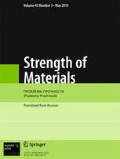The surface effect on the mechanical behavior of a nanowire forest indentation is theoretically studied. The use of a large-radius spherical indenter revealed a complex deformation pattern of the nanowire forest. The nanowire forest compression, buckling and postbuckling were analyzed. The effect of surface and packing density on the nanowire forest behavior with the indentation depth is discussed. The results show that the surface effect is of importance for in-depth hardness. The analysis is instrumental in measuring the mechanical properties of the nanowire forest and in designing nanowire-forest devices for various applications.





Similar content being viewed by others
References
M. Rana and M. R. Mohd Asyraf, “Investigation and development of vertically aligned carbon nanotube (VACNT) forest based temperature sensor,” Microelectron. Eng., 162, 93–95 (2016).
M. Salado, M. Oliva-Ramirez, S. Kazim, et al., “1-dimensional TiO2 nano-forests as photoanodes for efficient and stable perovskite solar cells fabrication,” Nano Energy, 35, 215–222 (2017).
Z. G. Zhu, L. Garcia-Gancedo, C. Chen, et al., “Enzyme-free glucose biosensor based on low density CNT forest grown directly on a Si/SiO2 substrate,” Sensor. Actuat. B - Chem., 178, 586–592 (2013).
M. R. Maschmann, Q. Zhang, F. Du, et al., “Length dependent foam-like mechanical response of axially indented vertically oriented carbon nanotube arrays,” Carbon, 49, No. 2, 386–397 (2011).
Z. M. Xiao, M. Dahmardeh, M. V. Moghaddam, et al., “Scaling approach toward nano electro-discharge machining: Nanoscale patterning of carbon nanotube forests,” Microelectron. Eng., 150, 64–70 (2016).
H. J. Qi, K. B. K. Teo, K. K. S. Lau, et al., “Determination of mechanical properties of carbon nanotubes and vertically aligned carbon nanotube forests using nanoindentation,” J. Mech. Phys. Solids, 51, Nos. 11–12, 2213–2237 (2003).
L. F. Wang, C. Ortiz, and M. C. Boyce, “Mechanics of indentation into micro- and nanoscale forests of tubes, rods or pillars,” J. Eng. Mater. Technol., 133, No. 1, 011014 (2011).
C. Q. Chen, Y. Shi, Y. S. Zhang, et al., “Size dependence of Young’s modulus in ZnO nanowires,” Phys. Rev. Lett., 96, No. 7, 075505 (2006).
R. E. Miller and V. B. Shenoy, “Size-dependent elastic properties of nanosized structural elements,” Nanotechnology, 11, No. 3, 139–147 (2000).
G. F. Wang and X. Q. Feng, “Effects of surface elasticity and residual surface tension on the natural frequency of microbeams,” Appl. Phys. Lett., 90, No. 23, 231904 (2007).
G. F. Wang and X. Q. Feng, “Surface effects on buckling of nanowires under uniaxial compression,” Appl. Phys. Lett., 94, No. 14, 141913 (2009).
J. He and C. M. Lilley, “Surface effects on the elastic behavior of static bending nanowires,” Nano Lett., 8, 1798–1802 (2008).
K. W. Qiu, Y. Lu, D. Y. Zhang, et al., “Mesoporous, hierarchical core/shell structured ZnCo2O4/MnO2 nanocone forests for high-performance supercapacitors,” Nano Energy, 11, 687–696 (2015).
X. P. Zheng, Y. P. Cao, B. Li B, et al., “Surface effects in various bending-based test methods for measuring the elastic property of nanowires,” Nanotechnology, 21, No. 20, 1719–1742 (2010).
R. C. Cammarate, “Surface and interface stress effects in thin films,” Prog. Surf. Sci., 46, No. 1, 1–38 (1994).
N. Challamel and I. Elishakoff, “Surface elasticity effects can apparently be explained via their nonconservativeness,” J. Nanotechnol. Eng. Med., 2, No. 3, 031008 (2011).
G. F. Wang and F. Yang, “Postbuckling analysis of nanowires with surface effects,” J. Appl. Phys., 109, 063535 (2011).
Acknowledgments
This study was performed within framework of Project No.11502197 supported by the National Natural Science Foundation of China, Project No. 2016JQ1032 supported by the Science and Technology Department of Shaanxi Province of China, Project No.16JK1504 and Post-Doctoral Program supported by the Education Department of Shaanxi Province of China.
Author information
Authors and Affiliations
Corresponding author
Additional information
Translated from Problemy Prochnosti, No. 1, pp. 130 – 137, January – February, 2018.
Rights and permissions
About this article
Cite this article
Yang, F. Surface Effect on the Nanowire Forest Indentation. Strength Mater 50, 116–123 (2018). https://doi.org/10.1007/s11223-018-9949-x
Received:
Published:
Issue Date:
DOI: https://doi.org/10.1007/s11223-018-9949-x




